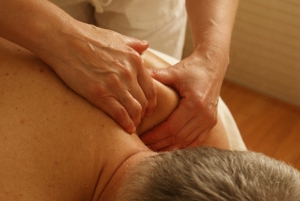
Preventing muscle aches & Strain
May 16, 2018
By Chris Semenuk RMT
Your muscles are your tools: You “knead” to learn ways to protect them from damage.

Your physically demanding career means that you should treat your muscles like a professional athlete to avoid aches and pains.
Stretching is an easy and effective way to make sure that baking doesn’t become a major pain. In this article I’ll discuss stretches that are specific to bakers.
There are different types of stretches: Static stretching means holding a position for a set period of time, while dynamic stretching means continuing to move through a stretch. Dynamic stretching has been shown to have the greatest benefit for avoiding aches and pains, but it is suggested to use both together.
STATIC STRETCHING
Static stretches only need to be held for 20 seconds to be effective. Try doing two to three sets of 20-second holds, stretching the muscle groups that tend to give you the most hassle at the end of the day. When holding, try stretching the muscle so that you can feel the stretch, but not to the point where it feels painful.
Hold your arm out straight in front of you, bend your wrist with your fingers pointing downward, and with your opposite hand pull back on the hand of the arm you are stretching. You should feel this stretch in the muscles on the top of your arm. Hold this for the 20 seconds, and then bend your wrist the other way with your fingers upwards and pull the hand back towards you again. Repeat this twice and then change arms.
DYNAMIC STRETCHING
Dynamic stretching gets your muscles used to the movement and builds up tolerance for your actual work.
Prepare for heavy lifting by starting with some basic back twists, knee bends, and arm circles. The idea is to start with smaller movements, and build up to larger ones that go beyond the range you would actually use.
Begin with bending your knees 20 degrees, stand up straight, and bend to 40 degrees. Stand up straight again, and keep repeating these movements until you are right down close to the ground. This should take about 30 seconds, or so, and you can also hold onto the counter for stability while doing this. This formula can be used with any joints.
If you are moving on to kneading or piping, then get your arms ready for the task. Make circles with your shoulder, elbow, and wrist joints. Just rotate them in the air in front of yourself for 30 seconds, making the circles gradually larger. Again, try to get a range that is larger what you will be using. If your work task, or “working zone” requires you to move your shoulder 45 degrees to each side, then make your circles 60 degrees or more. This will make it easier for your body to get to that 45 degree mark when you’re actually doing the task. This will prepare your muscles and joints so that you feel less aches and pains when you’re done.
Throughout your shift, and especially when getting back from a break, repeat the key stretches. Make sure to take frequent breaks and change position frequently.
PAIN RELIEF
If you’re feeling muscle and joint soreness, applying heat can help relieve some pain. Try a beanbag or heating pad; 10 minutes of heat should be enough for pain relief. If you’re having a hot shower, then let the water run over the sore area for about 20 minutes.
Massage therapy can help get to the areas and the deeper parts of the muscles that you just can’t do yourself. Massage therapy can help increase strength, improve function and reduce pain. Don’t try and work through the pain as that will make things worse. Your body will tell you when it needs help. Don’t ignore your body, it knows what it is talking about.
A massage therapist for 17 years, Chris has been involved in the profession as a professor, program creator, Pan-Am Lead Medical Professional, and Head RMT for Western University Track & Field and Cross Country.
Print this page
Leave a Reply